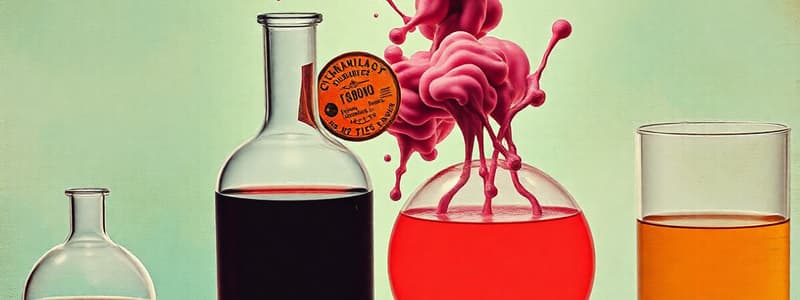Podcast
Questions and Answers
What is the fundamental concept in chemistry that is explored in this presentation?
What is the fundamental concept in chemistry that is explored in this presentation?
Acids and bases
According to the Arrhenius theory, what do acids produce when dissolved in water?
According to the Arrhenius theory, what do acids produce when dissolved in water?
- Chloride ions (Cl-)
- Sodium ions (Na+)
- Hydroxide ions (OH-)
- Hydrogen ions (H+) (correct)
Which of the following is an example of an Arrhenius base?
Which of the following is an example of an Arrhenius base?
- Sodium hydroxide (NaOH) (correct)
- Carbon dioxide (CO2)
- Ammonia (NH3)
- Hydrochloric acid (HCl)
The Brønsted-Lowry theory defines acids as proton donors.
The Brønsted-Lowry theory defines acids as proton donors.
What does ammonia (NH3) do in the Brønsted-Lowry theory?
What does ammonia (NH3) do in the Brønsted-Lowry theory?
Flashcards
Arrhenius Acids
Arrhenius Acids
Compounds that release hydrogen ions (H+) when dissolved in water.
Arrhenius Bases
Arrhenius Bases
Compounds that produce hydroxide ions (OH-) when dissolved in water.
Brønsted-Lowry Theory
Brønsted-Lowry Theory
The theory that describes acids and bases in terms of proton (H+) transfer.
Brønsted-Lowry Acid
Brønsted-Lowry Acid
Signup and view all the flashcards
Brønsted-Lowry Base
Brønsted-Lowry Base
Signup and view all the flashcards
Conjugate Base
Conjugate Base
Signup and view all the flashcards
Conjugate Acid
Conjugate Acid
Signup and view all the flashcards
Strong Acids
Strong Acids
Signup and view all the flashcards
Weak Acids
Weak Acids
Signup and view all the flashcards
Strong Bases
Strong Bases
Signup and view all the flashcards
Weak Bases
Weak Bases
Signup and view all the flashcards
Acid Strength
Acid Strength
Signup and view all the flashcards
Base Strength
Base Strength
Signup and view all the flashcards
pH Scale
pH Scale
Signup and view all the flashcards
Acidic Solution
Acidic Solution
Signup and view all the flashcards
Basic Solution
Basic Solution
Signup and view all the flashcards
Neutral Solution
Neutral Solution
Signup and view all the flashcards
Amphoteric Substance
Amphoteric Substance
Signup and view all the flashcards
Acid-Base Reaction
Acid-Base Reaction
Signup and view all the flashcards
Study Notes
Acids and Bases Overview
- Acids and bases are fundamental concepts in chemistry
- Different definitions, properties, and applications of these compounds are explored
Arrhenius Theory of Acids and Bases
- Definition: Acids produce hydrogen ions (H+) when dissolved in water. Bases produce hydroxide ions (OH-) when dissolved in water.
- Examples: Hydrochloric acid (HCl) releases H+ ions, while sodium hydroxide (NaOH) releases OH- ions.
Brønsted-Lowry Definition of Acids and Bases
- Proton Transfer: Acids are proton donors (H+), and bases are proton acceptors (H+).
- Examples: HCl donates a proton to water, forming H3O+, and ammonia (NH3) accepts a proton from water, forming NH4+ and OH-.
Conjugate Acids and Bases
- Conjugate Acid-Base Pairs: An acid and its conjugate base differ by a proton, and a base and its conjugate acid differ by a proton.
- Examples: HCl (acid) and Cl- (conjugate base) differ by a proton, and NH3 (base) and NH4+ (conjugate acid) differ by a proton.
Strong and Weak Acids and Bases
- Strong Acids: Ionize completely.
Studying That Suits You
Use AI to generate personalized quizzes and flashcards to suit your learning preferences.




